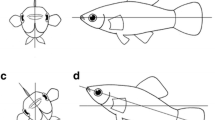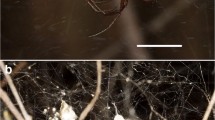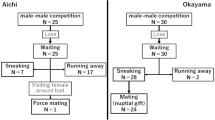Abstract
In nicrophorine beetles, genus Nicrophorus care their larva using small vertebrate carrion, whereas genus Ptomaucopusreproduce with small vertebrate carrion but show no parental care. Aggression and sexual behavior were examined in Ptomascopus morio and Nicrophorus quadripunctatus. Nicrophorus quadripunctatus had intense female–female as well as male–male contests. In Ptomascopus morio, by contrast, female–female aggression was rarely observed. Male–male aggression (pushing, biting, male–male mounting) in Ptomascopus morio was observed when a resource for breeding was present, whether or not a female was present. The lack of female–female aggression, and male–male aggression when resources but not females are present, suggest that the mating system of Ptomascopus morio is resource defense polygyny. Large males of Ptomascopus morio were also found to exhibit mate choice, preferring large females over small females.
Similar content being viewed by others
References
Bartlett, J. (1988). Male mating success and parental care in Nicrophorus vespilloides (Coleoptera: Silphidae). Behav. Ecol. Sociobiol. 23: 297–303.
Barlett, J., and Ashworth, C. M. (1988). Brood size and fitness in Nicrophorus vespilloides (Coleoptera: Silphidae). Behav. Ecol. Sociobiol. 22: 429–434.
Bateman, A. J. (1948). Intra-sexual selection in Drosophila. Heredity 2: 349–368.
Clutten-Brock, T. H. (1991). The Evolution of Parental Care, Princeton, Princeton University Press.
Davies, N. B. (1991). Mating systems. In Krebs, J. R., and Davies, N. B. (eds.), Behavioural Ecology An Evolutionary Approach, 3rd edn., Blackwell, London, pp. 263–294.
Eggart, A. K., and Sakaluk, S. K. (1995). Female-coerced monogamy in burying beetles. Behav. Ecol. Sociobiol. 37: 147–153.
Eggert, A. K., and Müller, J. K. (1997). Biparental care and social evolution in burying beetles: Lessons from the larder. In Choe, J. C., and Crespi, B. J. (eds.), The Evolution of Social Behavior in Insects and Arachnids, Cambridge University Press, Cambridge, pp. 216–236.
Eggert, A. K., Reinking, M., and Müller, J. K. (1998). Parental care improves offspring survival and growth in burying beetles. Anim. Behav. 55: 97–107.
Müller, J. K., and Eggert, A. K. (1989). Paternity assurance by “helpful” males: Adaptations to sperm competition in burying beetles. Behav. Ecol. Sociobiol. 24: 245–249.
Nagano, M., and Suzuki, S. (2003). Phenology and habitat use among Nicrophorine beetles of the genus Nicrophorus and Ptomascopus (Coleoptera: Silphidae). Edaphologia 73: 1–9.
Otronen, M. (1988). The effect of body size on the outcome of fights in burying beetles (Nicrophorus). Ann. Zool. Fenn. 25: 191–201.
Peck, S. B. (1982). The life history of the Japanese carrion beetle Ptomascopus morio and the origins of parental care in Nicrophorus (Coleoptara, Silphidae, Nicrophorini). Psyche 89: 107–111.
Peck, S. B., and Anderson, R. S. (1985). Taxonomy, phylogeny, and biogeography of the carrion beetles of Latin America (Coleoptera: Silphidae). Quaest. Entomol. 21: 247–317.
Pukowski, E. (1933). Okologische untersuchungen an Necrophorus F. Z. Morphol. Öekol. Tiere 27: 518–586.
Poethke, H. J., and Kaiser, H. (1987). The territoriality threshold: A model for mutual avoidance in dragonfly mating systems. Behav. Ecol. Sociobiol. 20: 11–19.
Scott, M. P. (1998). The ecology and behavior of burying beetles. Ann. Rev. Entomol. 43: 595–618.
Szalanski, A. L., Sikes, D. S., Bischof, R., and Fritz, M. (2000). Population genetics and phylogenetics of the endangered American burying beetle, Nicrophorus americanus (Coleoptera: Silphidae). Ann. Entomol. Soc. Am. 93: 589–594.
Thornhill, R., and Alcock, J. (1983). The Evolution of Insect Mating Systems, Harvard University Press, Cambridge.
Trivers, R. L. (1972). Parental investment and sexual selection. In Campbell, B. (ed.), Sexual Selection and the Descent of Man, Aldine, Chicago, pp. 136–179.
Trumbo, S., Kon, M., and Sikes, D. (2001). The reproductive biology of Ptomascopus morio, a brood parasite of Nicrophorus. J. Zool. Lond. 255: 543–560.
Trumbo, S. T. (1990). Interference competition among burying beetles (Silphidae, Nicrophorus). Ecol. Entomol. 15: 347–355.
Trumbo, S. T. (1994). Interspecific competition, brood parasitism and the evolution of biparental cooperation in burying beetles. Oikos 69: 241–249.
Trumbo, S. T., and Sikes, D. S. (2000). Sexual selection and leg morphology in Nicrophorus orbicollis and Ptomascopus morio. Entomol. Sci. 3: 585–589.
Wilson, D. S., Knollenberg, W. G., and Fudge, J. (1984). Species packing and temperature dependent competition among burying beetles (Silphidae, Nicrophorus). Ecol. Entomol. 9: 205–216.
Author information
Authors and Affiliations
Corresponding author
Rights and permissions
About this article
Cite this article
Suzuki, S., Nagano, M. & Trumbo, S.T. Intrasexual Competition and Mating Behavior in Ptomascopus morio (Coleoptera: Silphidae Nicrophorinae). J Insect Behav 18, 233–242 (2005). https://doi.org/10.1007/s10905-005-0477-8
Received:
Revised:
Issue Date:
DOI: https://doi.org/10.1007/s10905-005-0477-8




